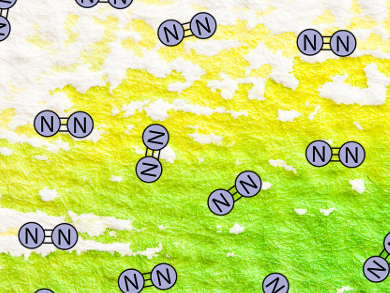Converting the relatively inert dinitrogen in the atmosphere into more useful species, such as ammonia, is an extremely important process, both in nature and in the chemical industry.
Iron complexes of the type [Fe(N2)(dmpe)2] (dmpe = 1,2-bis(dimethylphosphino)ethane) were shown to be active in the reduction of dinitrogen to ammonia as early as 1991. The complex was generated in situ from an iron(II) precursor and reacted with strong acids to give ammonium ions. However, the iron(0) species said to be responsible for the reaction could not be isolated at the time and similar compounds did not produce ammonia upon reaction with HCl.
Andrew E. Ashley, Imperial College London, UK, and colleagues have synthesized the bridged complex [Fe(dmpe)2]2(μ-N2), which reacts with N2 to give the iron(0) species [Fe(N2)(dmpe)2]. The team showed that this complex generates ammonia and hydrazine (N2H4) upon reaction with triflic acid, thus confirming its activity in nitrogen fixation. The mix of products leads the researchers to propose a mechanism via hydrazine intermediates.
In addition, the researchers synthesized the analogous [Fe(N2)(depe)2] complex (depe = 1,2-bis(diethylphosphino)ethane), which also reduces dinitrogen. The compound showed a particularly high efficiency for the generation of N2H4 and NH3.
- Teaching old compounds new tricks: efficient N2 fixation by simple Fe(N2)(diphosphine)2 complexes,
Laurence R. Doyle, Peter J Hill, Gregory G Wildgoose, Andrew Edward Ashley,
Dalton Trans. 2016.
DOI: 10.1039/C6DT00884D




